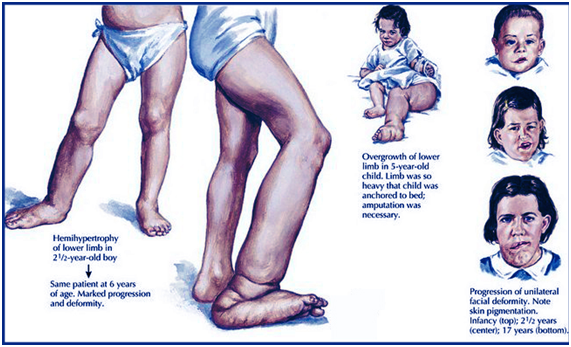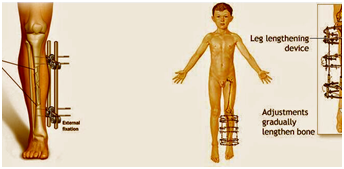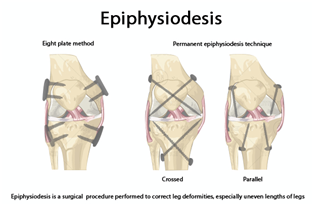Hemihypertrophy treatment in Gurgaon, Delhi NCR
Dr. Ratnav Ratan is a pediatric orthopedic surgeon in Gurgaon and Delhi NCR offering treatment to resolve Hemihypertrophy of limb conditions in children. An accomplished orthopedic surgeon with nearly thirteen years of experience in pediatric orthopedics and sports injuries,
Dr. Ratnav Ratan is known for his passionate approach towards best possible recovery of his patients. Hemihypertrophy is referred to as overgrowth syndrome or hemihyperplasia. In this condition, there is uneven growth on both sides of the body, i.e. one side of the body registers more growth than the other side of the body. Hemihypertrophy condition affects upper and/or lower extremities and facial features. Children with Hemihypertrophy need to be checked for tumors.

Signs of Hemihypertrophy
- One side of the body is distinctly larger or overgrown
- The length of the legs is uneven which is corrected by using a shoe lift
- Macroglossia or a large tongue condition leading to feeding and speech issues
- Pancreas, kidney, liver, and adrenal glands are larger than normal in size
- High risk of developing cancers such as Wilm’s tumor, tumor of the liver, and other rare tumors during childhood
- Defects in the abdominal wall of the child
- Low blood sugar conditions
Causes of Hemihypertrophy
Hemihypertrophy can or cannot be genetic. Beckwith-Wiedemann syndrome is one of the causes of Hemihypertrophy. This syndrome occurs due to abnormality in chromosome 11 that leads to differential growth in the sides of the body.
In other cases wherein a chromosome 11 abnormality leads to Hemihypertrophy, its occurrence is due to chance and they are unlikely to be passed within the family especially in future children.
Most cases of hemihypertrophy happen first time in the family due to a genetic change and the parents cannot be responsible for this.
Beckwith Wiseman Syndrome
Beckwith-Wiedemann syndrome is a genetic disorder that can be recognised at birth. Beckwith-Wiedemann syndrome has many characteristics associated with it. Children could be born with a few of them or a single but a prominent one amongst them viz. hemihypertrophy of a limb. The other characteristics include overgrowth of one side or one part of the body, large birth weight and length, hypoglycemia conditions, defects in the abdominal wall, an enlarged tongue and so on.
Genetic testing is recommended to establish the presence and cause of the Beckwith-Wiedemann syndrome and hemihypertrophy. The Beckwith-Wiedemann syndrome occurs on account of genetic changes 11p, a specific chromosomal region. It occurs in equally in boys and girls and it occurs in say 1 in 11,000 births.
Proteus Syndrome
Proteus Syndrome is distinguished by an overgrowth of bones, skin, muscles, fatty tissues, blood and lymphatic vessels. This is a progressive condition while children are born without any distinct deformities but asymmetrical growth is distinct in all the four limbs and spine. These patients have limb length discrepancy, spine deformity along with periarticular limb distortions. They are likely to develop tumors of skin and bone growths in their early childhood years.
Neurofibromatosis type 1
Neurofibromatosis type 1 is an autosomal disorder that is caused by a mutation in the NF1 gene. This gene codes for the neurofibromin protein that presents skin lesions, spinal involvement and lower and upper extremity deformities. The other generalized skeletal abnormalities include osteoporosis/osteopenia, osteomalacia, shortness of stature, and macrocephaly while spinal abnormalities include scoliosis and kyphoscoliosis, congenital bowing and pseudoarthrosis of the tibia and the forearm, chest-wall deformities, overgrowth phenomenon of the extremity, and soft-tissue tumors
Diagnosis of Hemihypertrophy
Distinctly visible asymmetry differences in either side of the child’s body and above mentioned signs relate to the presence of the Hemihypertrohpy condition.
Genetic testing to confirm the presence and the type of hemihypertrophy is also recommended. Also, testing for tumor marker alpha-fetoprotein through regular sonography of the abdomen and suitable pathological testing is suggested till the child attains seven years of age. It is likely that children with Hemihypertrohpy and Beckwith-Wiedemann syndrome can develop cancer
Beckwith-Wiedemann syndrome is a subtype of hemihypetrophy which occurs in both boys as well as girls. It is known to occur in 1 out of every 11,000 births.
Treatment for hemihypertrophy
The treatment depends upon the difference that exists between both sides of the body. Leg length with differences up to 2 cms does not require treatment. Leg length differences beyond 2 cms require to be corrected through shoe lifts or surgery.
Surgery to correct the limb length is done by –
- Limb Shortening
In the case of a child with hemihypertrophy who has attained full growth, the longer limb is shortened to reduce the length of the longer leg. The treating surgeon will remove a part of the bone from the middle of the long bone and join it together using metal rods or plates and screws to enable healing and joining.

- Limb lengthening is performed on children with major discrepancies. This procedure is performed either internally or externally.
External lengthening – The treating surgeon cuts the bone of the shorter leg and applies an external fixator to the leg using pins and/or wires. This procedure begins after 5 days of the surgery and is done manually by either the patient or his or her caregiver. By doing so, the bones grow distant slowly giving space for the new bone to grow leading to lengthening of the limb. The bone is likely to lengthen 1 mm each day which means nearly 1 inch in a single month.
Internal lengthening. – The treating surgeon cuts the bone of the shorter leg to implant an expandable metal rod within it. The rod is capable of lengthening as per the movement of the limbs of the patient. Through this, the bones are gradually pulled away from each other enabling the bone to grow and fill up the void while the rod offers stability and alignment to the bone. 
For the best outcomes of both these procedures, the child has to undergo physical therapy and home exercise along with regular check-ups with the treating surgeon.
- Epiphysiodesis is a surgical procedure to stop or slow down the growth of the longer leg and enable the shorter leg to grow normally. It is performed in any of the two ways which are
The growth plate is prevented from growing further either through drilling it or scraping it. This allows the opposite leg to grow and match the length of the normal leg.
The growth of the growth plate is prevented by placing metal staples or a plate with screws on its sides. These staples are removed once the discrepancy of the length is resolved and both legs attain the same length.
Timing plays a crucial role in performing this procedure. The treating surgeon ensures that the equality in leg length is achieved by the time the child stops growing so the ideal age would be during mid-teens to later teenage years.
However, six-monthly checkups are essential to monitor the growth of the limbs and offer customized solutions to treat and manage limb length discrepancies.
Children with hemihypertrophy can grow and lead normal lives with normal intelligence. Most of them experience normal growth and with reduced risk of cancer by the time they reach adolescence. However, it is advisable to resolve leg length differences and other abnormalities through corrective surgery.
Dr. Ratnav Ratan is a leading pediatric orthopedic surgeon in Gurgaon and NCR available for consultation and treatment of children with affected limbs due to hemihypertrophy.




